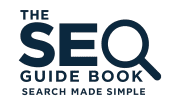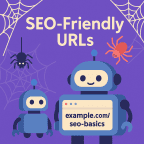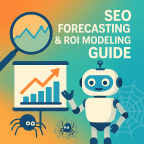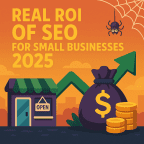What It Is & Why It Matters
On-page SEO (also known as on-site SEO) is the process of optimising individual web pages to rank higher and earn more relevant traffic in search engines.
This involves improving both the content and HTML source code of a page. Unlike off-page SEO – which deals with backlinks and external signals, on-page SEO is entirely within your control.
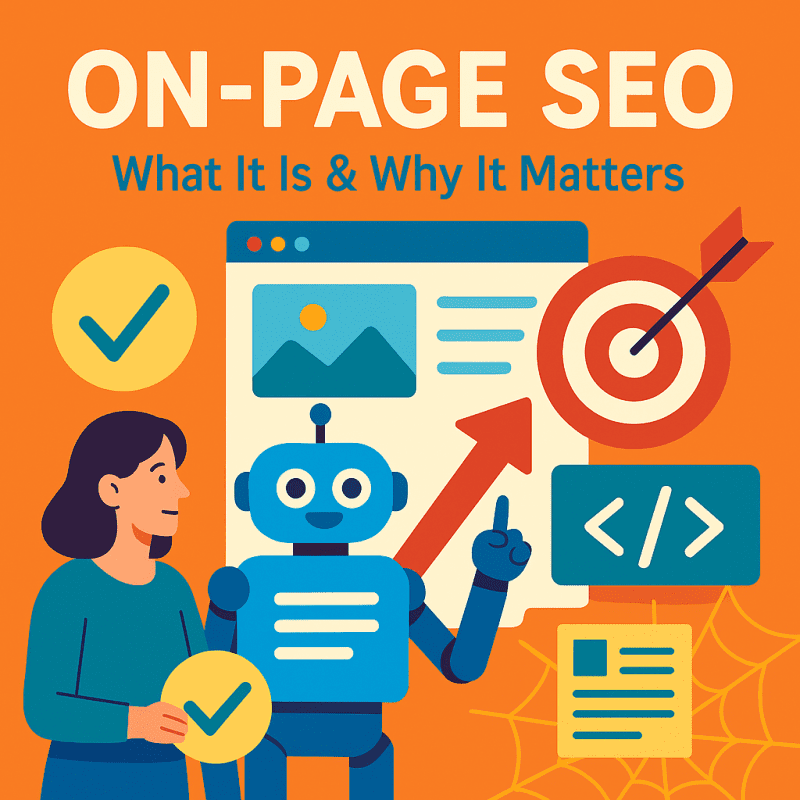
🔍 Why On-Page SEO Is Important
Search engines want to deliver the most relevant and useful content to users. On-page SEO helps search engines understand your content, index it properly, and rank it effectively. If your pages aren’t optimised, they might be overlooked – no matter how good your content is.
🧠 Key Elements of On-Page SEO
Here are the core factors you should be optimising:
- 🏷️ Title Tags – Your page title should be unique, descriptive, and include the main keyword near the beginning.
- 📋 Meta Descriptions – This short summary under your title in search results should entice clicks. It doesn’t directly affect rankings but impacts your click-through rate.
- 🖋️ Header Tags (H1, H2, H3…) – Break up your content using headers. These help users navigate and give search engines context.
- 🔑 Keywords – Naturally include your target keywords in the page title, headers, intro, and throughout the content – but don’t stuff them.
- 📄 High-Quality Content – Your content should answer the user’s query, be well-written, original, and informative.
- 🔗 Internal Linking – Link to other relevant pages on your site. It keeps users engaged and helps search engines crawl your website.
- 🌐 URL Structure – Keep URLs short, descriptive, and keyword-rich. E.g.,
/on-page-seois better than/page123?id=98. - 🖼️ Image Optimisation – Use descriptive filenames and alt text. Compress images to boost site speed.
- 📱 Mobile-Friendliness – Ensure your content displays well on all devices. Use responsive design practices.
- ⚡ Page Speed – A fast-loading page improves user experience and rankings. Use caching, optimise images, and minimise scripts.
- 🔒 HTTPS – Secure websites (with SSL certificates) are favoured by Google and trusted more by users.
✅ On-Page SEO Best Practices
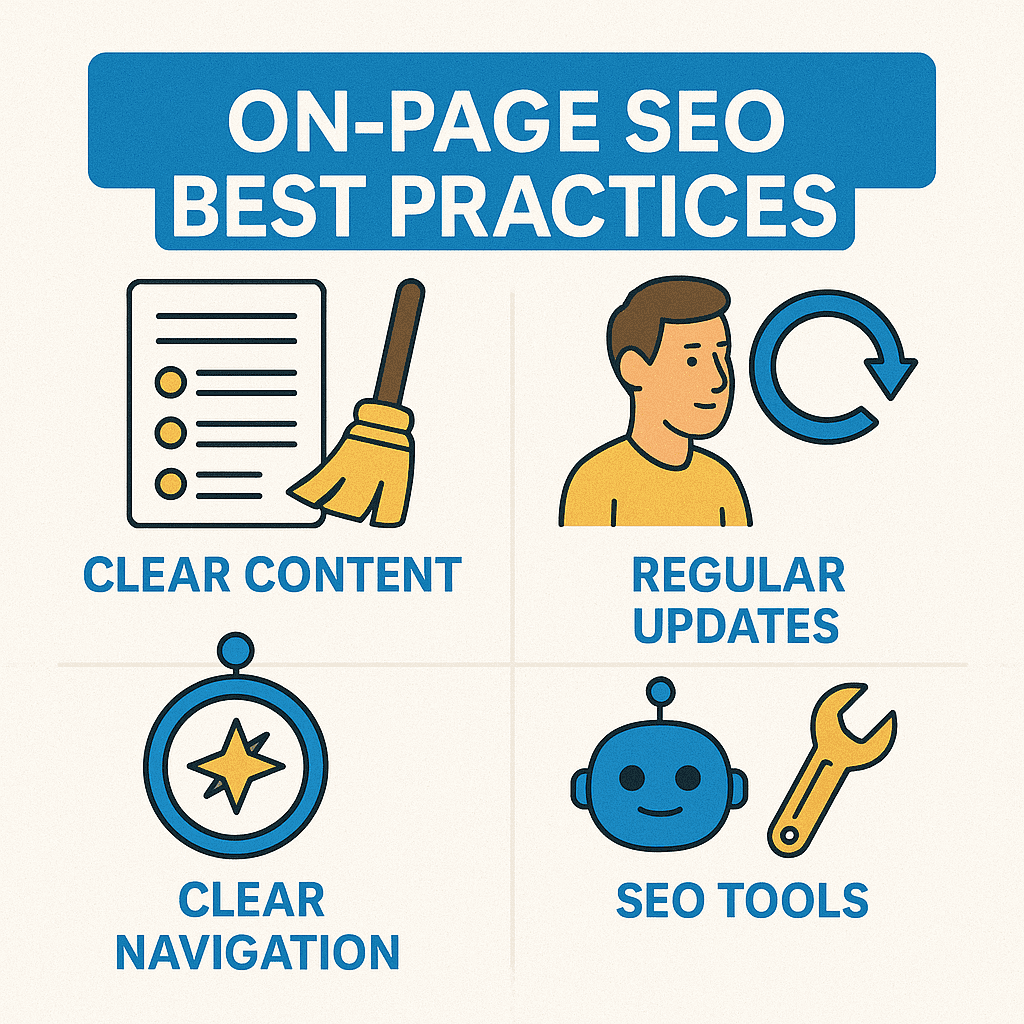
- 🧹 Keep content clear, concise, and structured using short paragraphs and bullet points.
- 🔁 Update content regularly to keep it fresh and accurate.
- 🧭 Use clear navigation to guide users and reduce bounce rates.
- 🛠️ Use SEO tools like Yoast SEO or Rank Math to help check your optimisation.
💡 Common Mistakes to Avoid
- 🚫 Keyword stuffing
- 📉 Thin or duplicate content
- ❌ Missing title tags or meta descriptions
- 🌀 Overly complex or long URLs
- 🕳️ Forgetting to link internally
🚀 Quick On-Page SEO Checklist
- ✅ Keyword in title tag
- ✅ Keyword in first 100 words
- ✅ At least one H2 with a keyword
- ✅ Optimised images with alt tags
- ✅ Internal links to relevant content
- ✅ External links to trustworthy sources
- ✅ Mobile-friendly layout
- ✅ Fast page speed (under 3 seconds)
🧰 Recommended Tools for On-Page SEO
📝 Recap and Clarify: Page-Specific FAQs
What is on-page SEO?
On-page SEO refers to optimising individual web pages to help them rank higher in search results. This includes improving content, HTML tags, page structure, and user experience.
Why is on-page SEO important?
It ensures that search engines understand your content and can index it properly. Without it, even great content might not rank well.
What are the key on-page SEO elements?
Title tags, meta descriptions, headers (H1–H3), keyword usage, internal links, URL structure, image optimisation, mobile-friendliness, and page speed.
How often should I update on-page SEO?
Review and update content every 6–12 months, especially if your rankings drop or search intent changes.
Do meta descriptions affect SEO rankings?
Not directly. But a well-written meta description can increase your click-through rate, which can impact overall SEO performance.
How many keywords should I use per page?
Focus on one main keyword and a few related terms. Use them naturally throughout your content without overstuffing.
Are images important for on-page SEO?
Yes. Use descriptive file names, alt tags, and compress images to improve site speed and accessibility.
What makes a good title tag?
It should be unique, include your main keyword, be under 60 characters, and entice clicks from searchers.
Does internal linking help SEO?
Yes. It improves site navigation, spreads link equity, and helps search engines understand your site structure.
What’s the difference between on-page and off-page SEO?
On-page SEO happens within your site (content, HTML, structure), while off-page SEO involves external factors like backlinks and brand mentions.
🧠 What the Experts Are Saying
“On-page SEO is the only part of search optimisation you fully control – ignore it, and you’re just hoping for luck.”
“If your content doesn’t align with user intent and your page doesn’t load quickly, you’ve already lost. On-page SEO is more than keywords – it’s user experience.”
“The best on-page SEO strategies make content digestible for both humans and machines. Think structure, clarity, and semantic richness.”
📌 Final Thoughts
On-page SEO is the foundation that turns good content into content that can be found.
By fine-tuning the visible touches – compelling title tags, clear headings, naturally placed keywords – and pairing them with invisible signals such as clean URLs, compressed images, rapid loading times and HTTPS security, you make each page both user-friendly and crawler-friendly.
Start small: run through the quick checklist on this page, then fix the easiest wins first – like adding an alt tag to each image or linking related articles together.
Next, move on to deeper optimisations such as rewriting meta descriptions to entice clicks or restructuring long articles with logical sub-headings. Avoid classic pitfalls like keyword stuffing, and duplicate paragraphs.
Video Recap – 🧩 On-Page SEO 2025 — The Complete Beginner’s Guide
Your website might look great – but is it actually optimised? In this video, I’ll show you how to master on-page SEO, from titles and meta descriptions to structure and UX – everything you need to climb Google’s rankings the right way.
